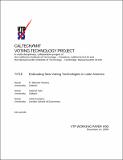| dc.contributor.author | Alvarez, R. Michael | |
| dc.contributor.author | Katz, Gabriel | |
| dc.contributor.author | Pomares, Julia | |
| dc.date.accessioned | 2015-04-15T16:00:53Z | |
| dc.date.available | 2015-04-15T16:00:53Z | |
| dc.date.issued | 2009-12-14 | |
| dc.identifier.uri | http://hdl.handle.net/1721.1/96623 | |
| dc.description.abstract | Having remained virtually unchanged since the enactment of universal and secret suffrage at the end of the nineteenth century, voting procedures are undergoing a radical transformation in many countries through the introduction of electronic methods of voting. Almost 30 countries around the world are currently in process of testing or implementing electronic voting, and in at least 10 countries e-voting is the main method used to elect national representatives (Alvarez and Hall 2008; Pomares 2009). Although it might be assumed that electronic voting would be more likely to arise in established democracies, e-voting has disseminated rapidly and extensively in the developing world. Two of the most populous democracies in the world, Brazil and India, are among the pioneers in switching to electronic voting (e.g., Rodrigues-Filho et al. 2006; Kumar 2008). Furthermore, one third of the countries testing electronic voting are in Latin America. What explains both of these trends? | en_US |
| dc.description.sponsorship | Carnegie Corporation of New York; John S. and James L. Knight Foundation; Pew Charitable Trusts | en_US |
| dc.language.iso | en_US | en_US |
| dc.publisher | Caltech/MIT Voting Technology Project | en_US |
| dc.relation.ispartofseries | VTP Working Paper Series;93 | |
| dc.title | Evaluating New Voting Technologies in Latin America | en_US |
| dc.type | Working Paper | en_US |
